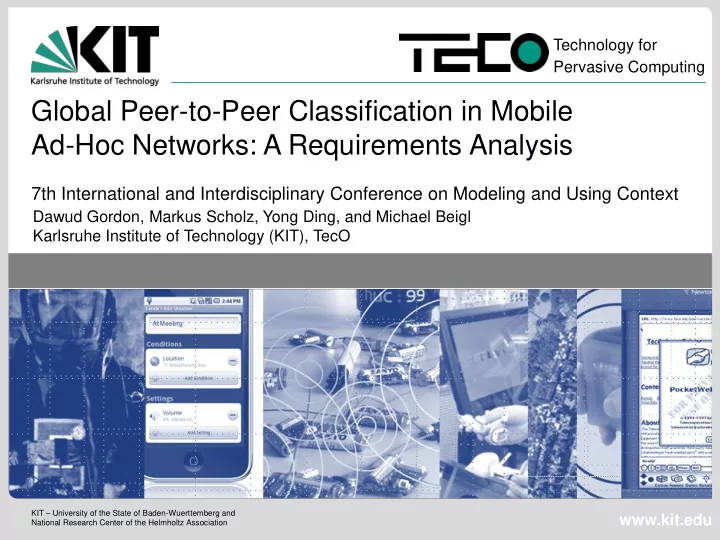

Technology for Pervasive Computing Global Peer-to-Peer Classification in Mobile Ad-Hoc Networks: A Requirements Analysis 7th International and Interdisciplinary Conference on Modeling and Using Context Dawud Gordon, Markus Scholz, Yong Ding, and Michael Beigl Karlsruhe Institute of Technology (KIT), TecO KIT – University of the State of Baden-Wuerttemberg and www.kit.edu National Research Center of the Helmholtz Association
Overview Motivating Scenario: Recognition of social group activities using mobile P2P devices Define how, what and why Observing Individuality What are we trying to Results from requirements recognize? and scenario Why it’s necessary How are we trying to do it? Why is in-network recognition needed? Resources Requirements Analysis Bounds for distribution Survival Brute force method (upper) Recovery Connectionist method Mapping ability (lower) Technology for 2 29.09.2011 Prof. Dr.-Ing. Michael Beigl Pervasive Computing
GAR using Mobile P2P Devices Devices collaborate to recognize group activity using embedded sensors Dawud Gordon Technology for 3 29.09.2011 Pervasive Computing
The activity recognition community My background: human activity recognition based on mobile sensor measurements Focus here: distributed input / processing Dawud Gordon Technology for 4 29.09.2011 Pervasive Computing
What and Why? What are we trying to recognize? Behavior of a group of social individuals Why and when on P2P devices? Sporadic access to infrastructure Expensive access (energy, bandwidth, etc.) No access (Autonomous) James Cridland Dawud Gordon Technology for 5 29.09.2011 Pervasive Computing
Requirement 1: Survival Recognition must survive nodes leaving without loss of recognition capabilities Dawud Gordon Technology for 6 29.09.2011 Pervasive Computing
Requirement 2: Recovery Recognition must not lose ability as individuals come and go Dawud Gordon Technology for 7 29.09.2011 Pervasive Computing
Requirement 3: Mapping Ability Which “social” context is to be recognized is not defined Approach must be able to model mapping from sensor values to contexts Dawud Gordon Technology for 8 29.09.2011 Pervasive Computing
Observing Individuality Assuming nodes are heterogeneous leads to problems! Constant subject “throughput” means data from new subjects are constantly introduced to system Eventually all original (training) subjects will be replaced Dawud Gordon Technology for 9 29.09.2011 Pervasive Computing
Related Work Parallel Computing: Global access to data Or, central merging/computation unit Collaborative Methods: Distributed voting Counts vote, not voter Organic Computing Multi-agent stigmergy approaches Produce a distributed stigmergic map Dawud Gordon Technology for 10 29.09.2011 Pervasive Computing
Possible solutions Several different algorithmic approaches Brute force redundant classifier Complete dissemination of all measurement data Connectionist approach: distribution of processing units across network Each node input, output and hidden processor Self Organizing Maps: distribution of data representation across network Dawud Gordon Technology for 11 29.09.2011 Pervasive Computing
Resource Consumption Analysis Assumption: distributed algorithm meeting requirements N: number of nodes in the network P: total processing load (per classification phase) M: total memory required by algorithm Algorithm Messages Processing/ Memory/ Passed Node Node Brute Force N(N-1) P M + S G (Worst Case) ANN 2N P/N M/N + S L Best Case N P/N M/N + S L Dawud Gordon Technology for 12 29.09.2011 Pervasive Computing
Summary In-network P2P classification is necessary: No, Restricted, or Intermittent access For functionality there are 3 requirements: Survival, Recovery and Mapping An upper and lower bound for resource consumption and distribution derived Brute force approach Distributed reasoning approach The importance of incorporating role elaborated on Dawud Gordon Technology for 13 29.09.2011 Pervasive Computing
That’s All Thank You! Questions? Dawud Gordon Technology for 14 29.09.2011 Pervasive Computing
Recommend
More recommend